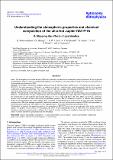Understanding the atmospheric properties and chemical composition of the ultra-hot Jupiter HAT-P-7b II. Mapping the effects of gas kinetics
Abstract
Aims. The atmospheres of ultra-hot Jupiters (UHJs) are commonly considered to be at thermochemical equilibrium. We aim to provide disequilibrium chemistry maps for a global understanding of the chemistry in the atmosphere of HAT-P-7b and assess the importance of disequilibrium chemistry on UHJs. Methods. We applied a hierarchical modeling approach using 97 1D atmospheric profiles from a 3D general circulation model of HAT-P-7b. For each atmospheric 1D profile, we evaluated our kinetic cloud formation model consistently with the local gas-phase composition in chemical equilibrium. This served as input to study the quenching of dominating CHNO-binding molecules. We evaluated quenching results from a zeroth-order approximation in comparison to a kinetic gas-phase approach. Results. We find that the zeroth-order approach of estimating quenching points agrees well with the full gas-kinetic modeling results. However, it underestimates the quenching levels by about one order of magnitude at high temperatures. Chemical disequilibrium has the greatest effect on the nightside and morning abundance of species such as H, H2O, CH4, CO2, HCN, and all CnHm molecules; heavier CnHm molecules are more affected by disequilibrium processes. The CO abundance, however, is affected only marginally. While dayside abundances also notably change, those around the evening terminator of HAT-P-7b are the least affected by disequilibrium processes. The latter finding may partially explain the consistency of observed transmission spectra of UHJs with atmospheres in thermochemical equilibrium. Photochemistry only negligibly affects molecular abundances and quenching levels. Conclusions. In general, the quenching points of the atmosphere of HAT-P-7b are at much lower pressures than in the cooler hot-jupiters. We propose several avenues to determining the effect of disequilibrium processes on UHJs that are in general based on abundance and opacity measurements at different local times. It remains a challenge to completely disentangle this from the chemical effects of clouds and that of a primordial nonsolar abundance.
Citation
Molaverdikhani , K , Helling , C , Lew , B W P , MacDonald , R J , Samra , D , Iro , N , Woitke , P & Parmentier , V 2020 , ' Understanding the atmospheric properties and chemical composition of the ultra-hot Jupiter HAT-P-7b II. Mapping the effects of gas kinetics ' , Astronomy & Astrophysics , vol. 635 , A31 . https://doi.org/10.1051/0004-6361/201937044
Publication
Astronomy & Astrophysics
Status
Peer reviewed
ISSN
0004-6361Type
Journal article
Description
Funding: Part of this work was supported by the German Deutsche Forschungsgemeinschaft, DFG project number Ts 17/2–1.Collections
Items in the St Andrews Research Repository are protected by copyright, with all rights reserved, unless otherwise indicated.
Related items
Showing items related by title, author, creator and subject.
-
Precise masses in the WASP-47 system
Vanderburg, Andrew; Becker, Juliette C.; Buchhave, Lars A.; Mortier, Annelies; Lopez, Eric; Malavolta, Luca; Haywood, Raphaëlle D.; Latham, David W.; Charbonneau, David; López-Morales, Mercedes; Adams, Fred C.; Bonomo, Aldo Stefano; Bouchy, François; Collier Cameron, Andrew; Cosentino, Rosario; Di Fabrizio, Luca; Dumusque, Xavier; Fiorenzano, Aldo; Harutyunyan, Avet; Johnson, John Asher; Lorenzi, Vania; Lovis, Christophe; Mayor, Michel; Micela, Giusi; Molinari, Emilio; Pedani, Marco; Pepe, Francesco; Piotto, Giampaolo; Phillips, David; Rice, Ken; Sasselov, Dimitar; Ségransan, Damien; Sozzetti, Alessandro; Udry, Stéphane; Watson, Chris (2017-11-17) - Journal articleWe present precise radial velocity observations of WASP-47, a star known to host a hot Jupiter, a distant Jovian companion, and, uniquely, two additional transiting planets in short-period orbits: a super-Earth in a ≈19 ... -
Three newly discovered sub-Jupiter-mass planets : WASP-69b and WASP-84b transit active K dwarfs and WASP-70Ab transits the evolved primary of a G4+K3 binary
Anderson, D. R.; Cameron, A. Collier; Delrez, L.; Doyle, A. P.; Faedi, F.; Fumel, A.; Gillon, M.; Chew, Y. Gomez Maqueo; Hellier, C.; Jehin, E.; Lendl, M.; Maxted, P. F. L.; Pepe, F.; Pollacco, D.; Queloz, D.; Segransan, D.; Skillen, I.; Smalley, B.; Smith, A. M. S.; Southworth, J.; Triaud, A. H. M. J.; Turner, O. D.; Udry, S.; West, R. G. (2014-12-01) - Journal articleWe report the discovery of the transiting exoplanets WASP-69b, WASP-70Ab and WASP-84b, each of which orbits a bright star (V ∼ 10). WASP-69b is a bloated Saturn-mass planet (0.26 MJup, 1.06 RJup) in a 3.868-d period around ... -
The well-aligned orbit of Wasp-84b : evidence for disk migration of a hot Jupiter
Anderson, D. R.; Triaud, A. H. M. J.; Turner, O. D.; Brown, D. J. A.; Clark, B. J. M.; Smalley, B.; Cameron, A. Collier; Doyle, A. P.; Gillon, M.; Hellier, C.; Lovis, C.; Maxted, P. F. L.; Pollacco, D.; Queloz, D.; Smith, A. M. S. (2015-02-10) - Journal articleWe report the sky-projected orbital obliquity (spin–orbit angle) of WASP-84 b, a 0.69 planet in an 8.52 day orbit around a G9V/K0V star, to be λ = −0.3 ± 1.7°. We obtain a true obliquity of ψ = 17.3 ± 7.7° from a measurement ...

